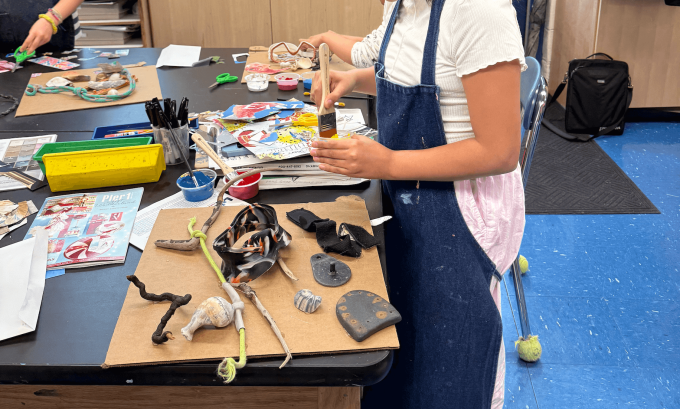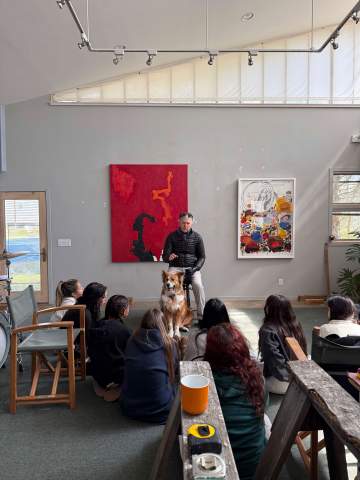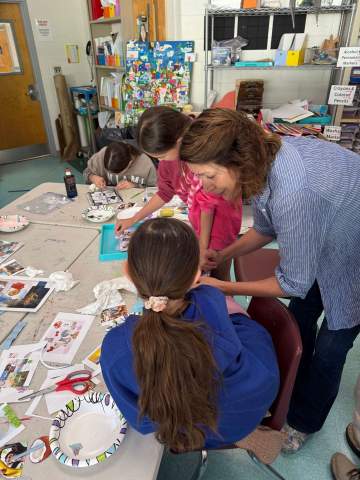
John M. Marshall Elementary School Workshop with artist Scott Bluedorn, 2025. Photo: Kayla Matters
It’s Back-to-School Time: Let These Students Teach you About Rauschenberg
Something special is happening on the East End of Long Island, thanks to a grant from the Robert Rauschenberg Foundation to Guild Hall in East Hampton in honor of the artist’s Centennial year. Guild Hall’s Student Art Festival, an annual tradition since 1938, partners regional artists with public school classrooms, with students producing works to eventually hang in Guild Hall’s East Hampton exhibition space.
This year, the program’s theme, Rauschenberg100, is simple but powerful: bring Rauschenberg’s boundary-breaking spirit into the hands of young artists, and watch what happens. Professional artists, selected and guided by Guild Hall, have been working with students from kindergarten through 12th grade across the East End’s public schools, organizing more than 100 workshops based on the artist’s practices. The program will culminate this fall with an exhibition of the students’ artworks at Guild Hall, alongside an exhibition of Rauschenberg’s work currently held in Guild Hall’s permanent collection, co-curated by Director of Visual Arts, Melanie Crader, and Guild Hall’s Teen Arts Council. Inspired by the cross-generational learning happening on the East End, we spoke with the teachers, artists, students, and teens involved in the program.

Learning by Doing, Creating by Playing
In Bridgehampton, artist Bastienne Schmidt was paired with third and fourth graders, an age group “that has an openness to ideas and process that is very appealing.” Her first workshop started with a visit to her own studio. “I started a dialogue with the students with the question: “What is art? And what does art mean to you?” Bastienne says. “Students were able to touch and play with various materials to get a feel for materiality of common household items as material.” Rauschenberg became part of the conversation almost naturally. “He was always open and interested in taking in new materials and unexpected forms and objects into his artwork. The kids loved the freedom of process.” This fall, her students are creating a collaborative fabric-and-found-material “flag,” patterned with their individual voices. Think Rauschenberg’s fabric works meets El Anatsui’s monumental weavings — sewn, glued, and full of movement.
For high schoolers in East Hampton, Peter Dayton took a similar approach to freedom: “I let them control the situation. Freedom to mix materials and techniques at their whim.” In his workshops, he introduced Rauschenberg’s work via Minutiae, a Combine from 1954. “I think they responded to this piece because it resembled a room or shelter that had many different areas,” Dayton said. “After an hour or two with the work, students started showing me what looked like renderings of primitive shelters on small areas of beach/sand as if it was a shipwreck. We are surrounded by water in East Hampton so it was interesting how many students went in that direction.”

The Combines also resonated strongly with students in working alongside artist Margaret Garrett, after she introduced Rauschenberg to fifty students enrolled in 5th to 7th grade at Shelter Island School with a “slide presentation of about twelve pieces.” After this introduction, students started to work on a small canvas with a photo transfer. A few weeks later, they had added paint, and used collage to add on other images and materials. “They made some really great unique pieces,” Garrett commented. “It was exciting to see the clarity of each person’s vision.” When students return to school after the summer break, they plan to continue with a similar project involving photo transfer and collage, but on a slightly larger scale. “I have asked that the kids take photos over the summer, at least once a week, so they are continuing to think about seeing and are collecting their own images that they may want to work with in the fall, rather than just finding something online.”
Meanwhile, Catherine Brigham, the art teacher at Shelter Island School which hosted Garrett, reflected: “Students were curious about Rauschenberg and his process, and Margaret’s workshops were an excellent access point.” As for the impact on the school, Brigham has no doubt that the effects will be long-lasting: “This project has reinforced the importance of community. In a small school like Shelter Island, I will be many of these students' only art teacher. Having the chance to work with talented and creative artists in the community to introduce famous artists like Rauschenberg is incredible. It gives students an ownership of the work and having it displayed in a place like Guild Hall gives them a great sense of pride.” Looking ahead to the fall, Brigham is working on organizing a field trip to Guild Hall to ensure every student gets the chance to see their work on display.
Students Learning, Students Leading
What happens this fall in Guild Hall’s galleries will largely be thanks to the hard work of the Guild Hall Teen Arts Council (TAC), with students like Ava Poblete and Ace Chaikin who bring their own enthusiasm and perspective. For Poblete, TAC was about finding another creative home: “The idea of having another creative outlet besides a school art club, where I can share and listen to other creative insights, was what pushed me to participate in the Teen Arts Council.” Poblete has already curated a show for Guild Hall; in 2024, for “Eco vs. Ego,” she was tasked with organizing local school students’ artworks. “This project not only fueled my passion for working in a museum exhibition but also made me appreciate the time and effort that others have put into these exhibits.“ Reflecting on her own growth, she added: “This program has greatly improved my way of speaking in groups, visualizing my own artistic ideas for others, and learning how to collaborate with other artists that may have a different technique than myself. Joining a program with such a diverse group of students with an artistic interest refines my own ability to create work.”
This fall, she won’t be collaborating with Chaikin, as he is off to college. He’ll take the spirit of the program with him: “It reinforced my belief that art brings people together, even when taste and preferences differ.” An artist himself, he had not heard of Rauschenberg before this collaboration. “His use of whatever-he-could-get-his-hands-on to create something was inspiring for me, and, since then, I have opened up my mind about what art-making could be made of.”
Students, Teachers, and Artists Join Forces — and Rauschenberg Is at the Heart of It All
Over the next few months, workshops will continue to unfold— more experiments, more unexpected materials, more kids taking big creative risks. From Saturday, November 15th through Sunday, January 4th, Guild Hall’s galleries will burst with the results: student artworks alongside Rauschenberg pieces from the Guild Hall collection. For many students, this will be their first time seeing their art in a museum alongside that of a major artist who broke rules, mixed mediums, and made space for possibility. As Bastienne Schmidt states: “Creating art is like being in a magical playground. Anything goes. You can make the rules, and change them.” The spirit of the Festival isn’t just in the work — it’s in the way this community of young artists, teachers, and mentors is coming together right now, in real time, to make something bigger than themselves. And like Rauschenberg, they’re proving that art can happen anywhere, with anything — as long as you’re open to the process.
